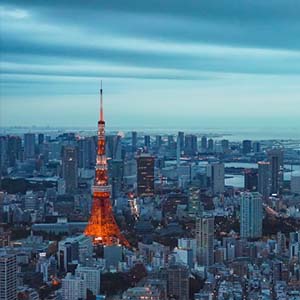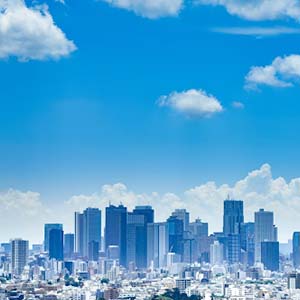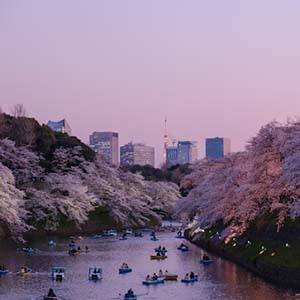Moving to Tokyo
Tokyo has been described as a unique city of contrasts. As a young capital city, established in 1868, it has developed to be the centre of Japan in a political, governmental, financial, educational, business, and cultural sense. It’s high living costs have not deterred many foreign companies from having their headquarters in Tokyo. Tokyo is a crowded and busy place with fine restaurants, a range of entertainment opportunities and a dynamic business environment.
Overwhelming is a word used to describe Tokyo, in every aspect. It is made up of 23 wards, 26 smaller cities, seven towns, and eight villages, adding up to around 800 square miles. This space is home to around 13.6 million people, and 25% of Japan’s population lives within commuting distance of the capital. Buildings of stunning design can be found directly next to an expanse of dreary residential or business structures.
Getting around in Tokyo
When moving to Tokyo, finding your way around can be a difficult task to begin with. Addresses are often confusing as Tokyo grew into a city from a collection of villages, making its layout a little chaotic. Addresses for buildings consist of the district within Tokyo, the area in which it exists, and their time of development. Large maps can usually be found at train and subway stations.
Getting around will rely on major landmarks, experience, questions, and map cards. If you find yourself lost in Tokyo, try the following:
- Ask someone – foreigners travelling through Tokyo might know where to point you and people in shops or on the street will usually try to help you
- Find a station – “Eki wa doku desu ka?” or “Where is the station?”
- Ask at a police station – at local stations, there should be at least one officer who will speak some English
- Hail a Taxi

Public Transportation
When moving to Tokyo, it’s a relief to know that the public transport in Tokyo and the rest of Japan make travelling around the city and country easy. The network of public transport links ensures that you can get where you need to go safely.
Subway and Rail: The fastest way to get around in Tokyo is via subway and commuter rail. Japan Railways (JR) loop lines circle the city and 10 lines cross Tokyo’s centre. Tokyo Metro provides a guide to the system, maps, and an app to assist users. Station names will be written in Japanese kanji as well as in Roman letters and many signs at stations will be written in English.
Commuter trains can get extremely busy and “pushers” on platforms will shove as many people onto trains as possible. There are often cars reserved for women, school students, and disabled passengers. Train environments are passive with a lack of eye contact to be expected.
Tickets: You can purchase tickets for the Subway and Rail services at machines, which take any combination of yen and give change. You can also get prepaid magnetic cards as well as regular passes. Remember to keep your ticket until you exit the station. Fares are calculated on distance and there is a Tokyo Metro English language fare calculator. If still unsure, buy the minimum ticket and pay the difference to the ticket-taker when you exit.
Airport Transportation
There are two airports that service Tokyo: Haneda Airport and Narita Airport. Haneda services mainly domestic flights, whereas Narita handles more international transport.
Haneda International Airport: Haneda is located 10 miles southwest of Tokyo. This airport supplies domestic flights as well as China Airlines arriving from Taiwan. Monorail is the best way to travel from Haneda to the city centre, taking a little over 15 minutes. Taxi trips take up to an hour and can be expensive. Rental cars are also available, as well as an Airport Limousine Bus.
Narita International Airport: Narita Airport is 70km east of Tokyo and serves most of all international flights from Tokyo. There are many rail connections between the airport and the city centre, the fastest being Narita Express Train which takes around 1 hour and 15 minutes. Taxi rides will be expensive to the city and have minimal baggage room. There are also shuttle bus services to some nearby hotels and to the city centre. Rental cars are also available.
Finding Housing in Tokyo
There is a range of accommodation types around the city of Tokyo. While there are many apartment options when you are moving to Tokyo, the process can be complicated. There are many fees involved with rental properties, particularly for foreigners moving to Tokyo. It is highly recommended that you contact a local estate agent or acquire the help of an international relocation company to ensure that everything is sorted correctly.
Gerson Relocation offers assistance in finding housing as part of our Relocation Services. Get a free quote for your relocation today.

Where is the best place to live in Tokyo?
The best place to live when moving to Tokyo will depend on many personal factors. This includes whether you are moving to Tokyo with family, where you will be working, and any other requirements.
Areas of Tokyo that lie within the circle of the Yamanote train line are most popular among foreigners and expats, meaning that rent within this area is generally high. If moving to Tokyo with family many expatriates recommend ensuring children are accepted into a school before you decide where to live. There are many areas and neighbourhoods that have detailed handbooks published in English for new residents to the area. The following are some wards that are popular with expatriates moving to Tokyo called ‘ku’ and their neighbourhoods within the Yamanote train line.
Meguro-ku: This ward in Tokyo offers a suburban experience with a traditional Japanese residential style. There is a lot of green space in these areas and numerous local schools including Sacred Heart, The British School, and the Seisen International School. Popular areas here include Aobadai, Gakugei-Daigaku, Gotanda and more, all with convenient public transport links to the city centre.
Minato-ku: This is one of the most convenient commuter wards but also the most expensive ward in Tokyo. There is a high concentration of expatriates living in this ward, giving it an international feel. There are local services and facilities that are convenient to foreigners’ needs, with large US-style grocery stores available and the Tokyo American Club. The Nishimachi International School is located in this ward, as is the American School in Japan, and there are excellent school bus services for students.
Setagoya-ku: This is a popular ward among US expatriates. It has a quiet, relaxed atmosphere and there are a lot of parks and a lot of greenery to enjoy. While the commute to the city is only 10-20 minutes, there is a less frequent service so many find a car necessary in this area. Local international schools Saint Mary’s and the Seisen International School are accessible here. Popular neighbourhoods for expatriates include Den ‘en-chofu, Fukazawa, Kamiuma, Shimo-Kitazawa, and Shimouma.
Shibuya-ku: Due to the more traditional residential ambience and a larger supply of houses, this ward is increasing in popularity among expatriates moving to Japan. There are convenient and frequent transport links to the city centre making the commute into Tokyo particularly easy. If moving to Tokyo with family, this could be a great ward to choose as there are a variety of international schools here, including the ASIJ Nursery-Kindergarten, Aoba International School, and the British School. Popular neighbourhoods for expatriates moving to Tokyo include e Daikanyama, Ebisu, Harajuku, Hiroo and Shoto.
Tokyo Suburbs: For expatriates moving to Tokyo with more limited budgets, searching for accommodation outside of the Yamanote train line is a good idea. Areas of Tokyo beyond the Yamanote Line either to the west, following the Shibuya, Shinjuku and Ikebukuro lines, or to the east, to the Gyotoku and Disneyland area.
Short Term Housing
When renting accommodation in Japan, leases are normally a minimum of 2 years. As a result, expatriates moving for a shorter length of time choose temporary housing for their stay in Tokyo. The majority of Tokyo’s temporary housing can be found in the Minato-ku or Roppongi areas, where public transport links remove the need for a private vehicle.
If struggling to find short-term housing, Gerson Relocation can help. We offer assistance in your search for Temporary Accommodation when relocating to Japan.

Expat Life in Tokyo
Moving to Tokyo can be an overwhelming experience. Thankfully, Tokyo is full of foreigners from all over the world. A strong community of expatriates exists in Japan with the centre being Tokyo. There are many opportunities to meet fellow expatriates living in Japan, from meet-up websites, apps, and local activity groups. If moving to Tokyo with family, kids’ schools are an excellent place to strike up relationships and friendships. Getting to know other expatriates in Tokyo will give some great tips on navigating Japanese etiquette, language practice, and local facilities. They could also help with navigating life with a language barrier, such as finding English-speaking doctors.
As a cultural and entertainment centre of Japan, Tokyo has plenty of opportunities on offer for people of all interests. To find out about entertainment facilities, new openings, and festivals, check out the Tokyo Travel Guide website.

Understanding the people of Tokyo
Moving to Tokyo can present you with a whole new set of rules. Japan’s history saw a ban for foreigners for over 100 years, meaning their culture is strong and precious to Japanese people. This is no different in Tokyo. Etiquette in Japan can be complicated to navigate, and you are expected to do your research out of respect for your host country.
The Japanese are traditional people, and their customs are rooted in respect for others. For more tips on Japanese Etiquette, read these Essential Tips to avoid causing offence when living in Tokyo.
Our Relocation Services don’t end when you step into Tokyo. We offer Cultural Training services to settle you into your new home.
Interested in information on another country? Take a look at our other International Relocation guides.
Great customer Experiences start here
Very pleasent and helpful. Nothing too much trouble.
Mr M H moved from London, UK to Toronto, Canada
Very helpful and patient even when things got packed that we had to get out again!
Mr M E moved from Enfield, UK to Dorset, UK
Thanks to Graham, Nick and the entire crew!
Mr C D M moved from UK to Singapore
Friendly and helpful crew.
Ms T W moved from USA to Cambridgeshire, UK
